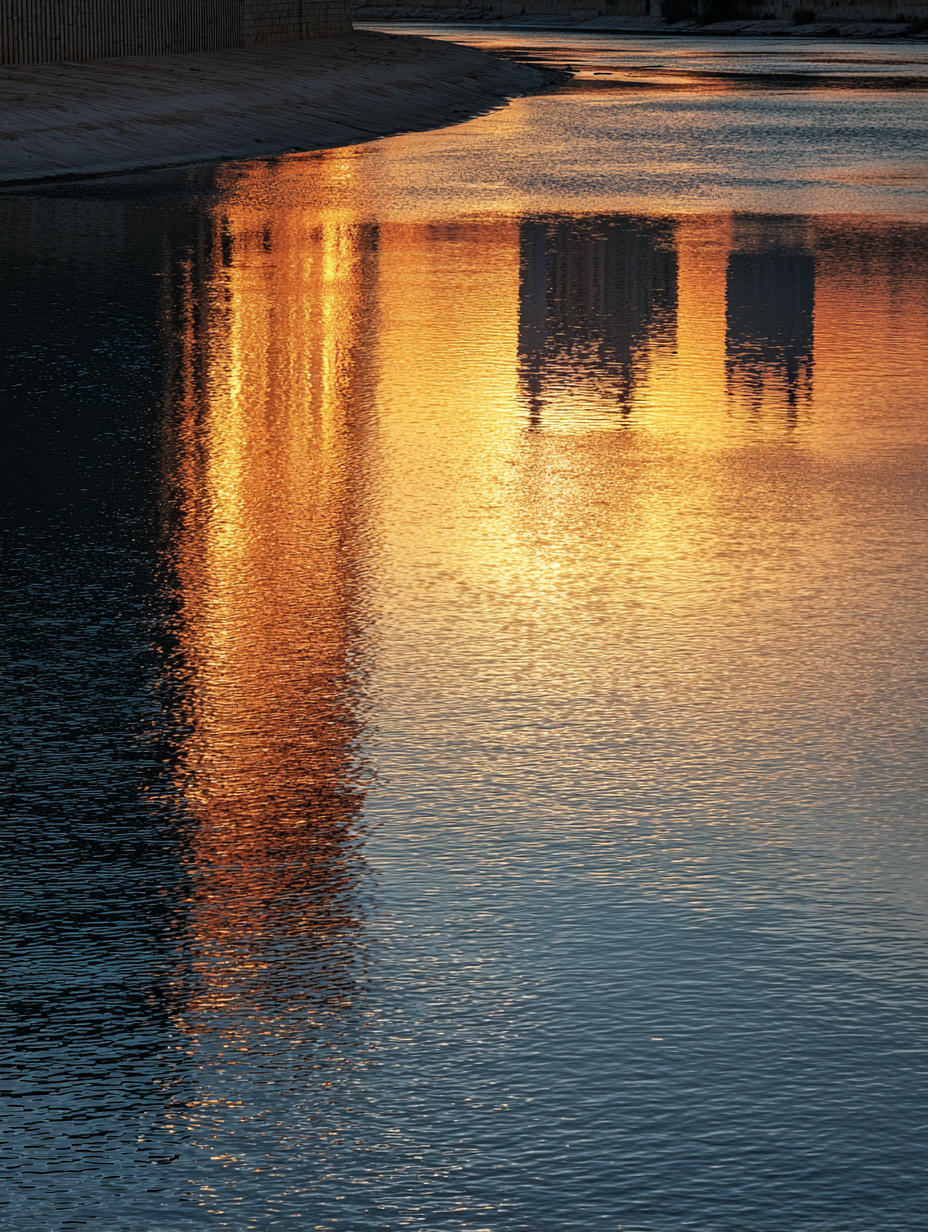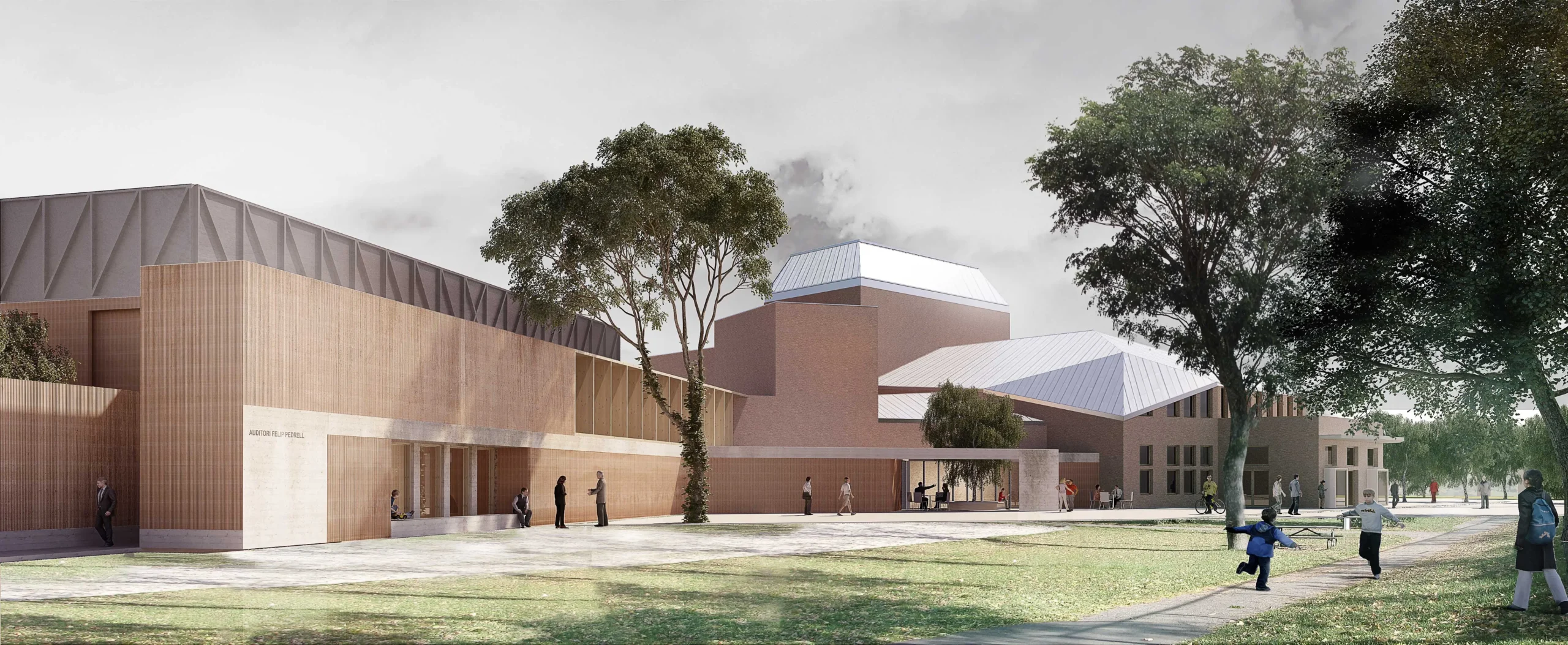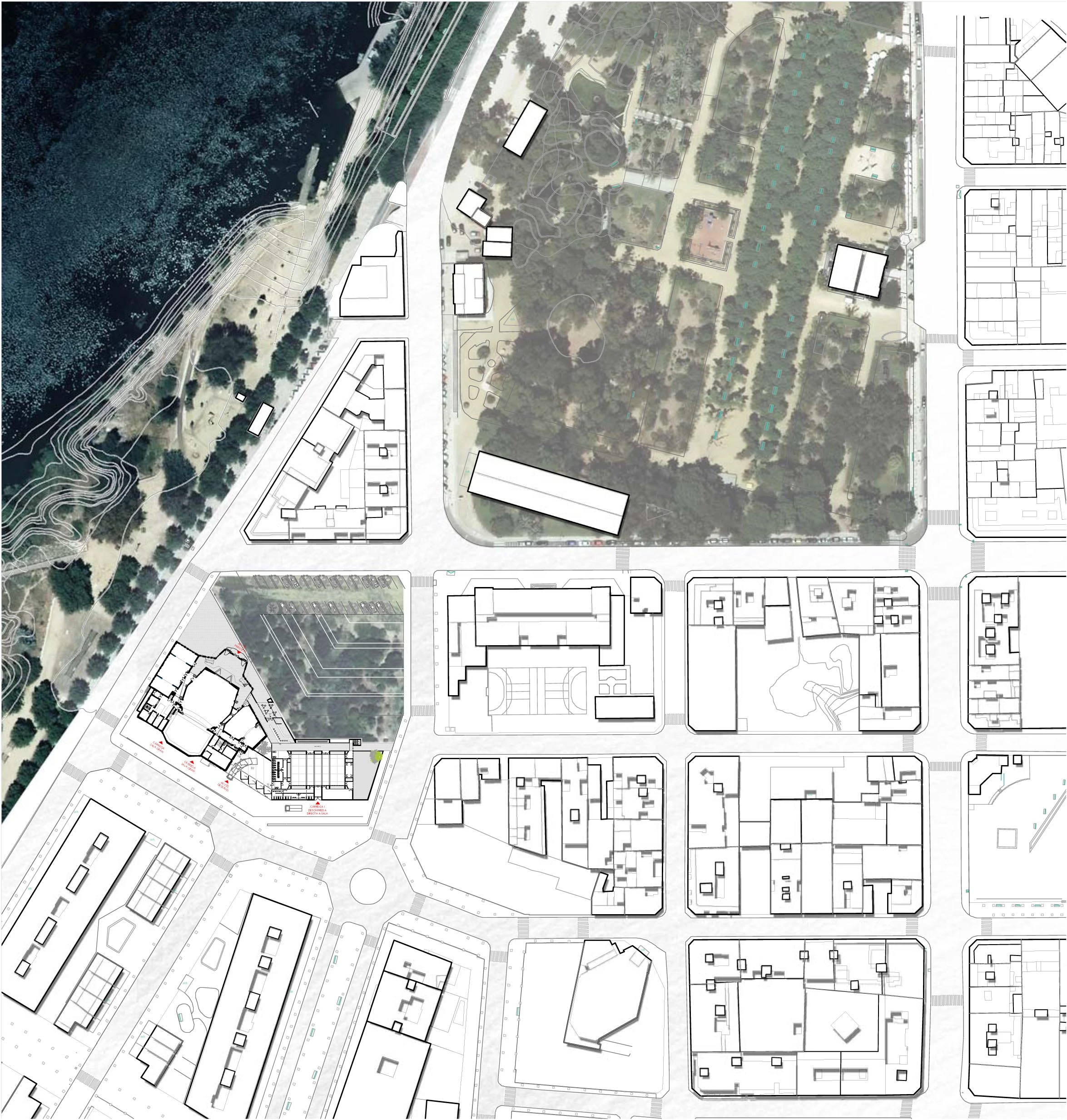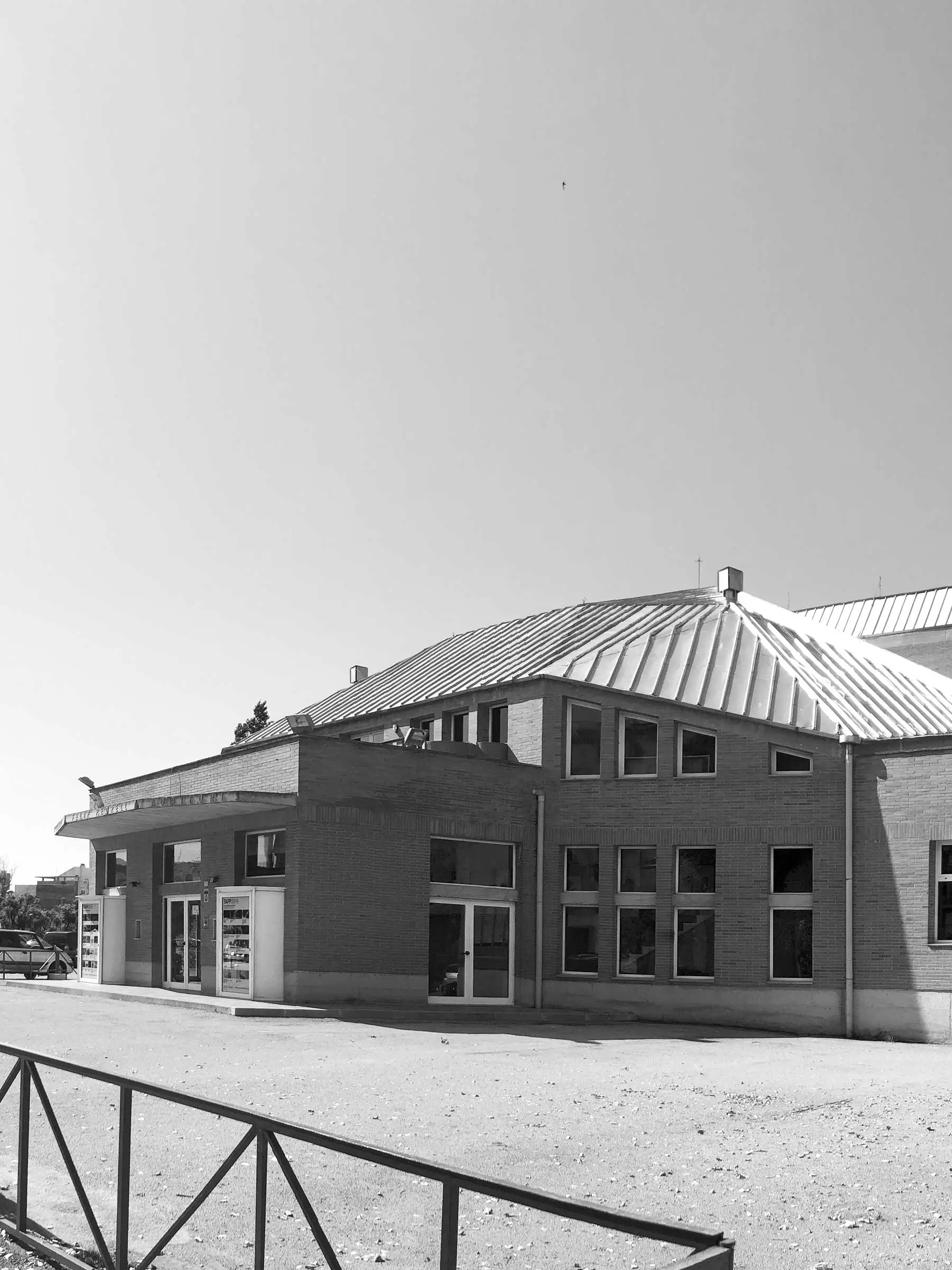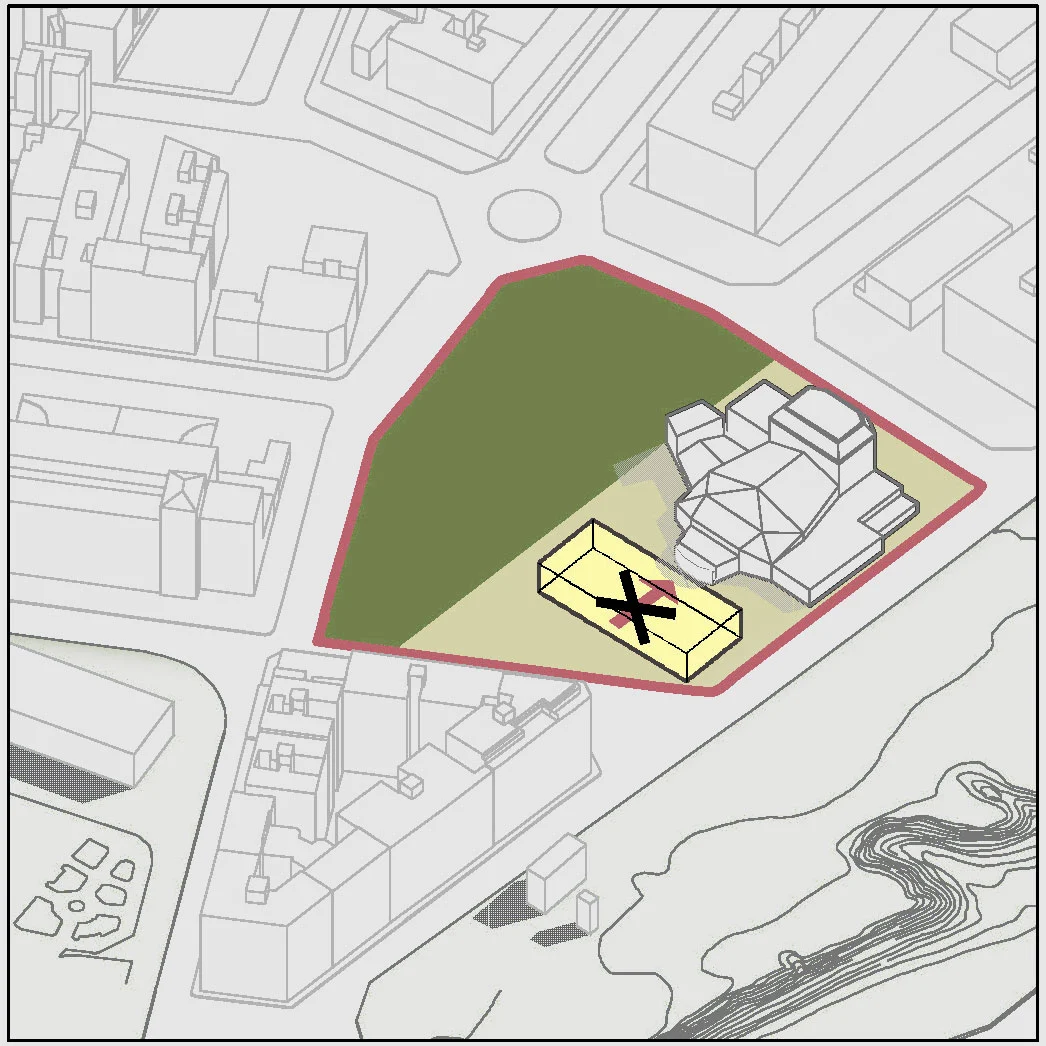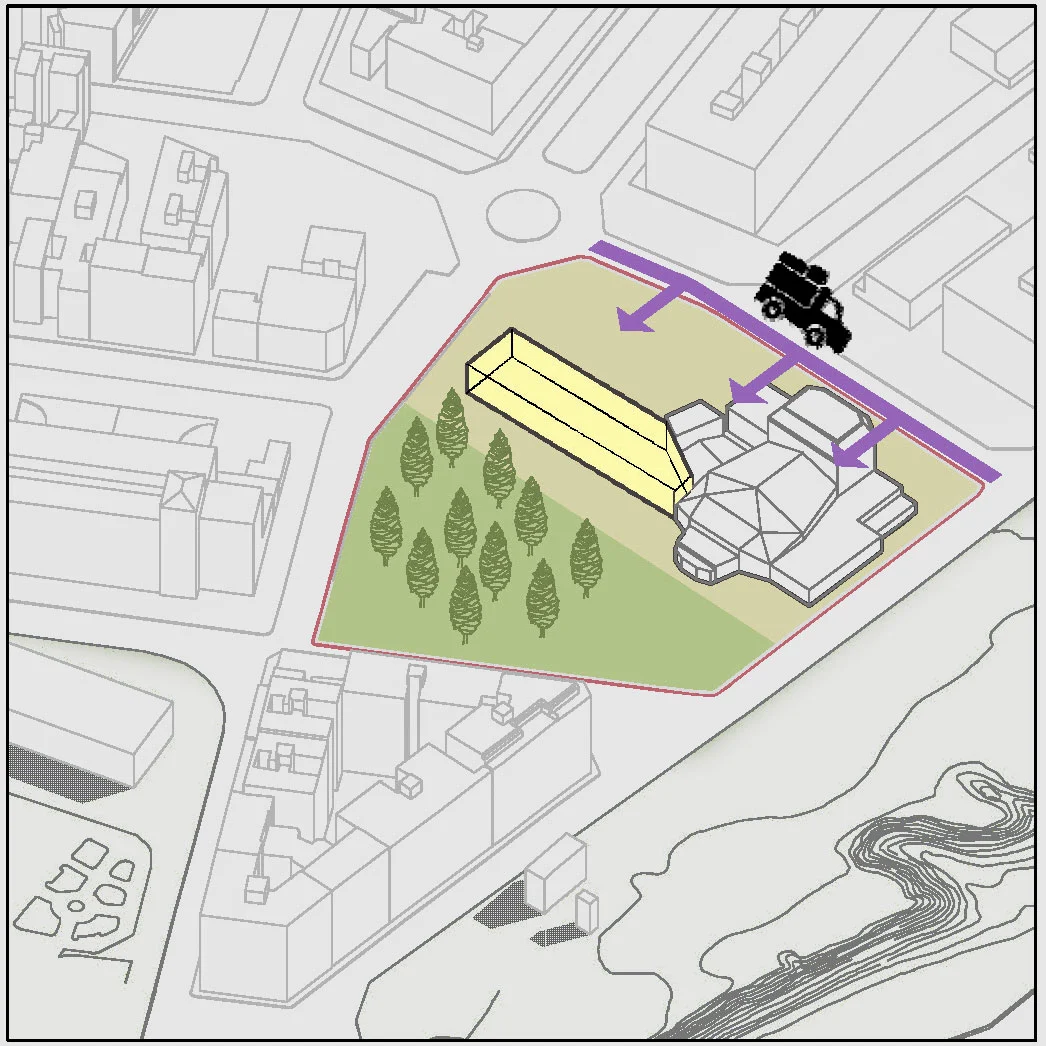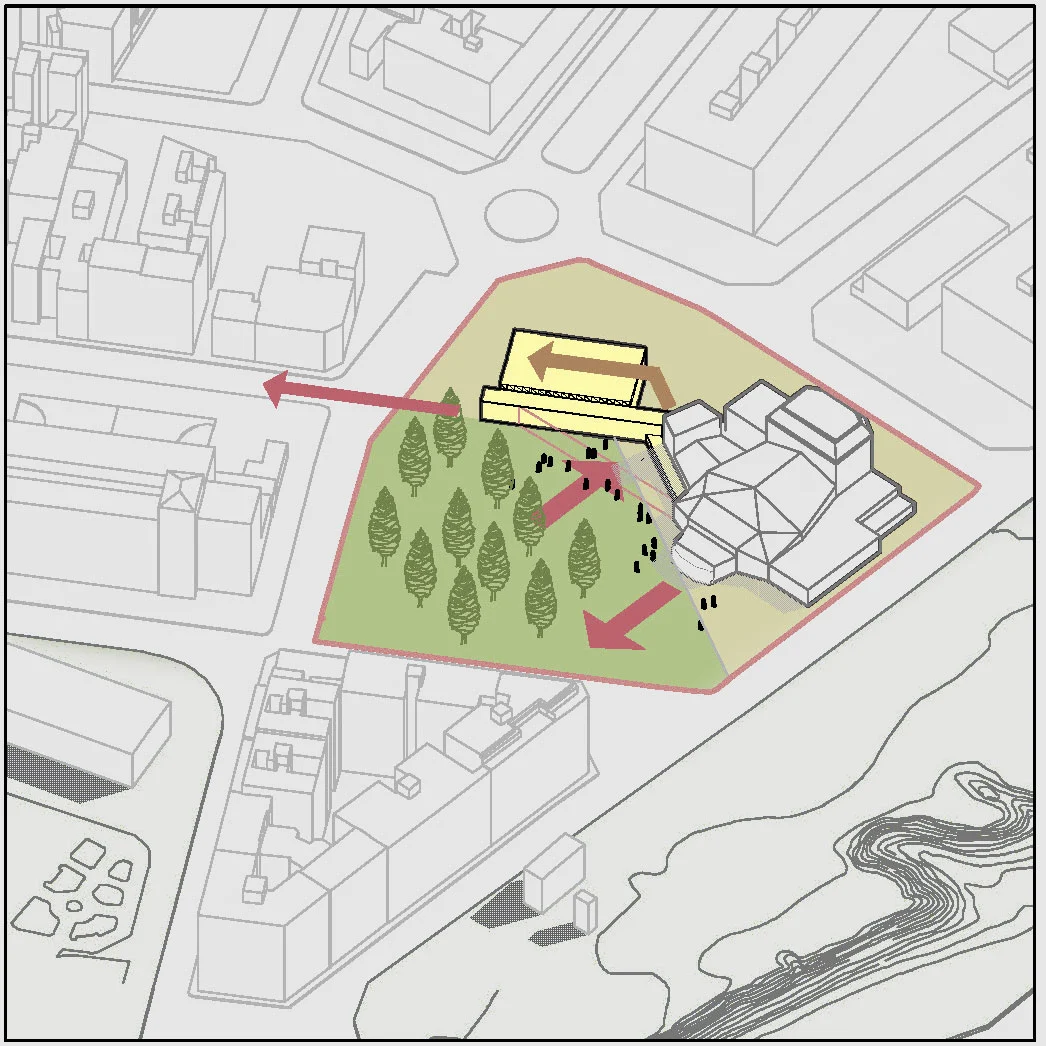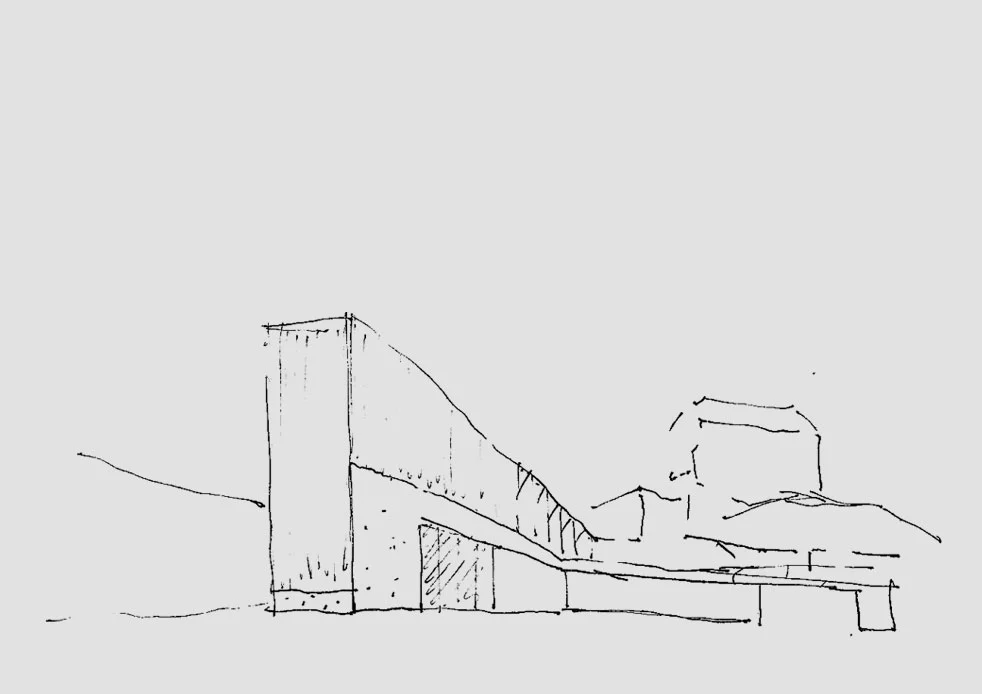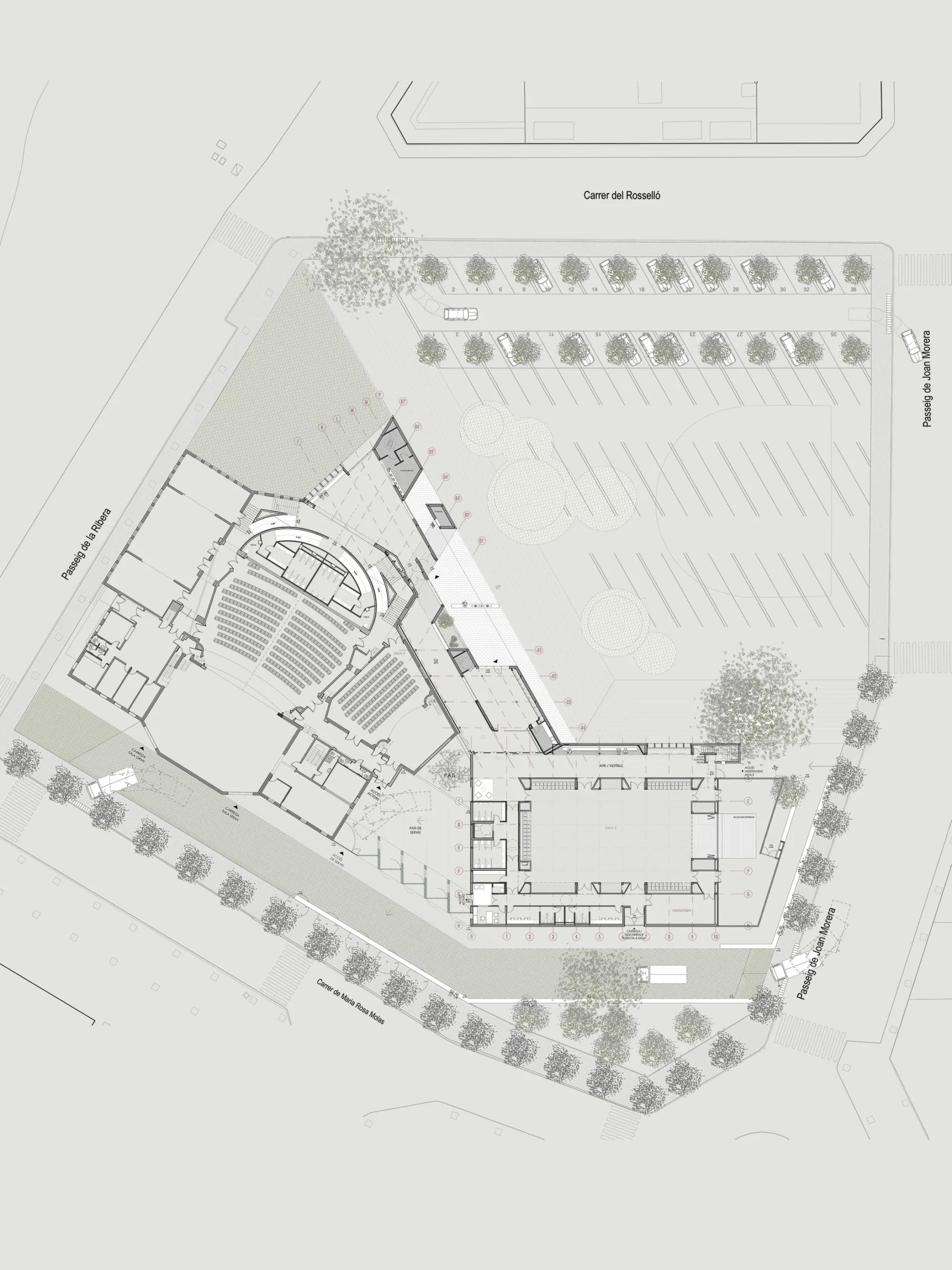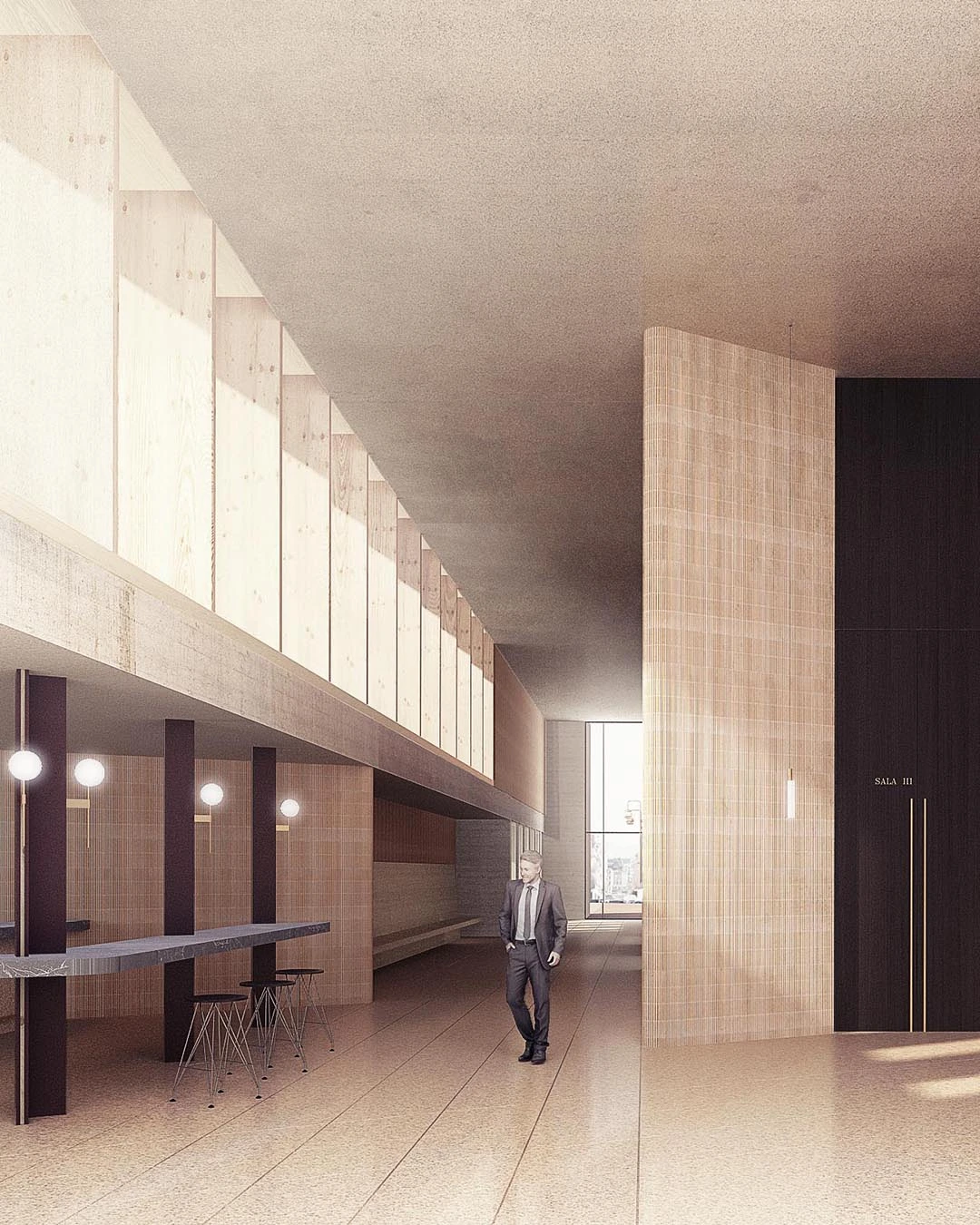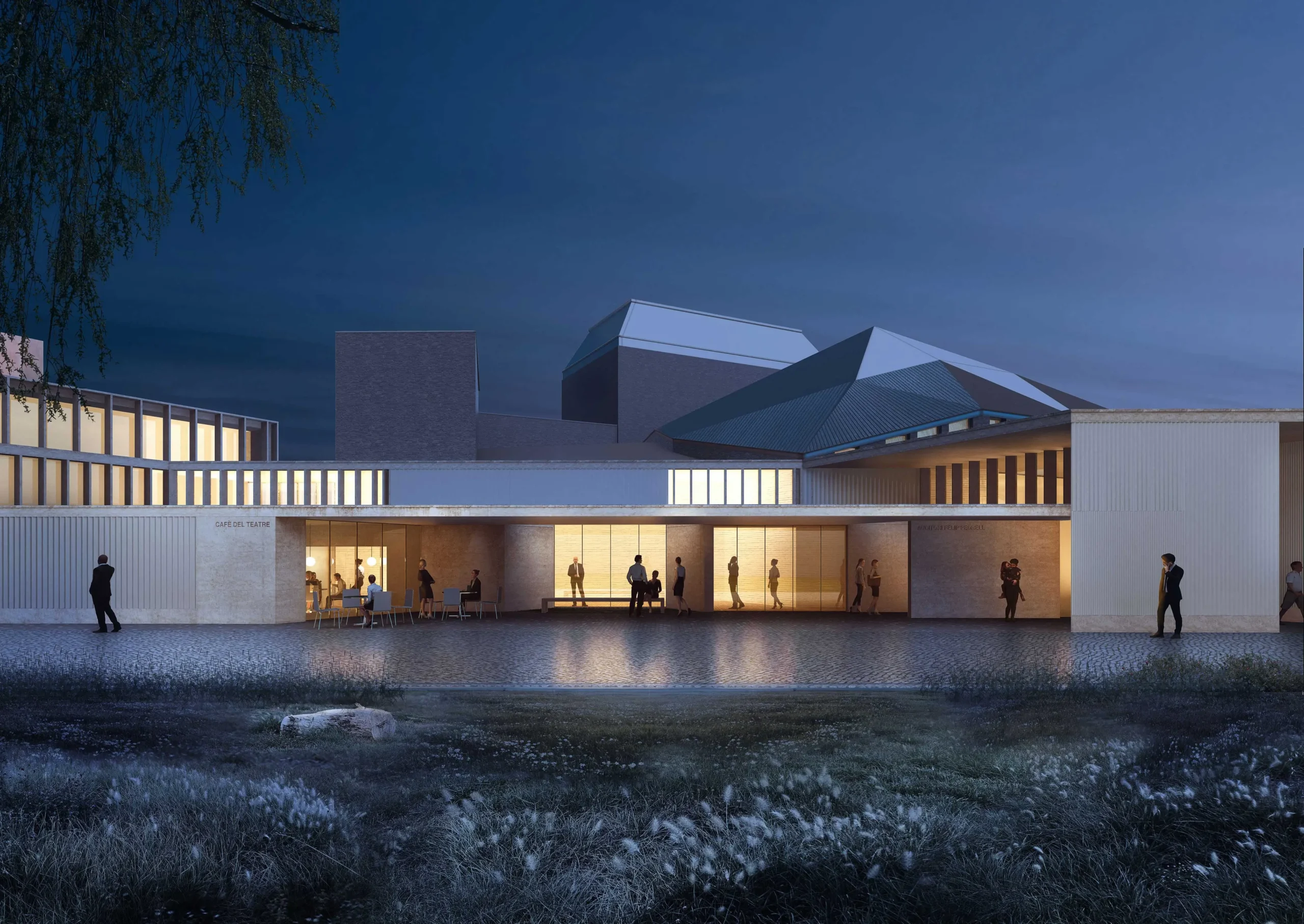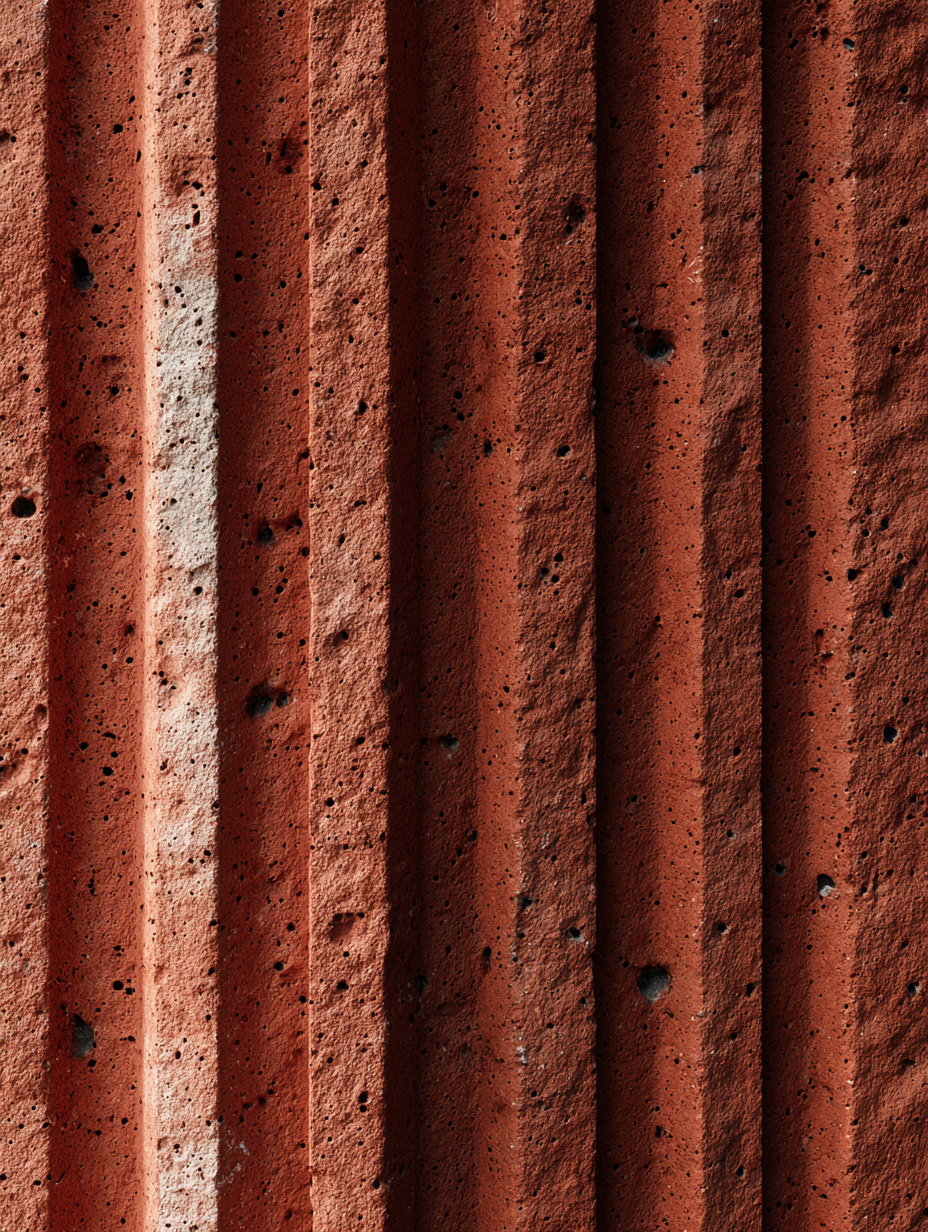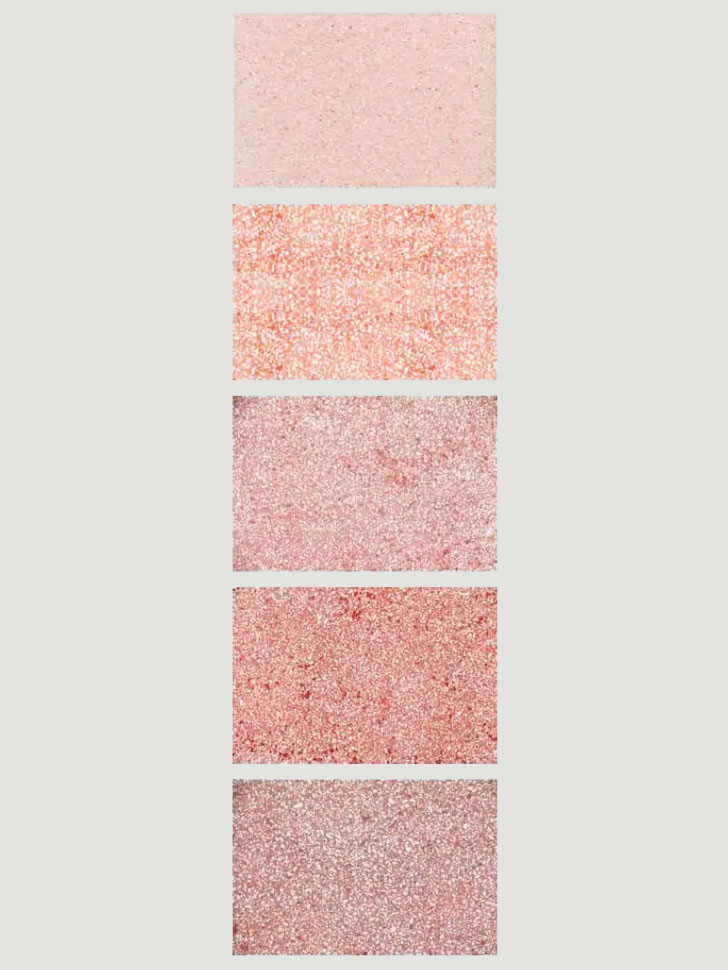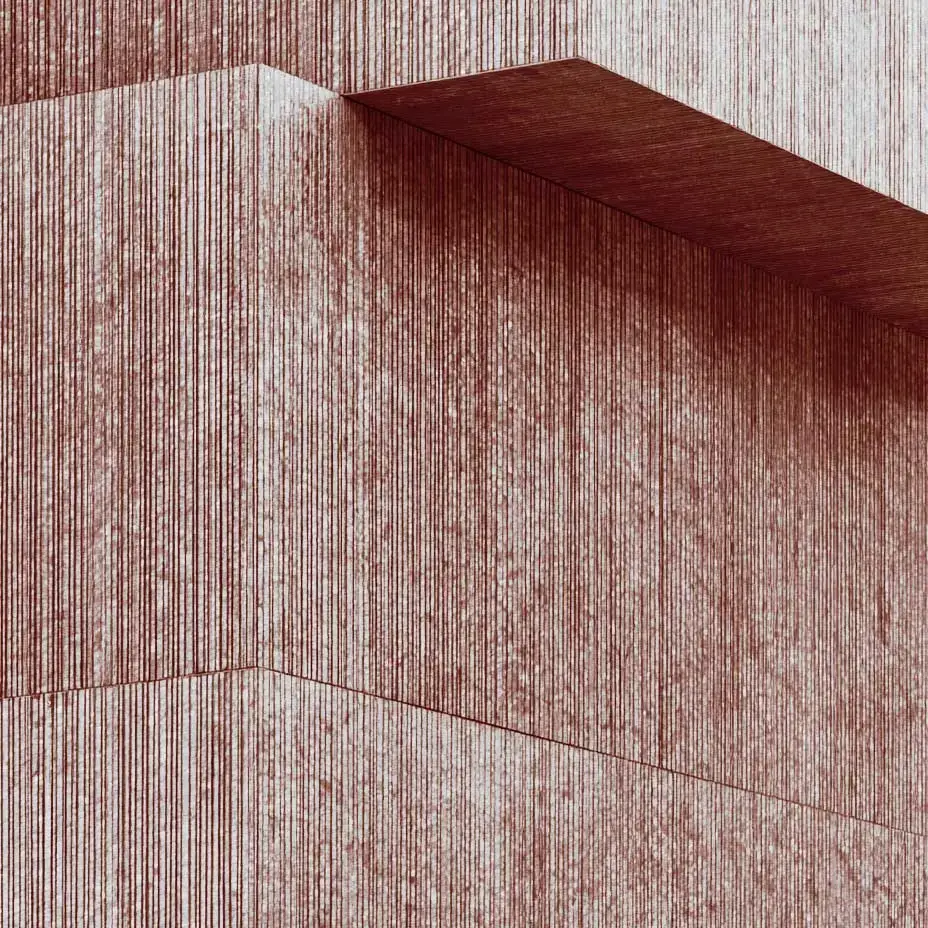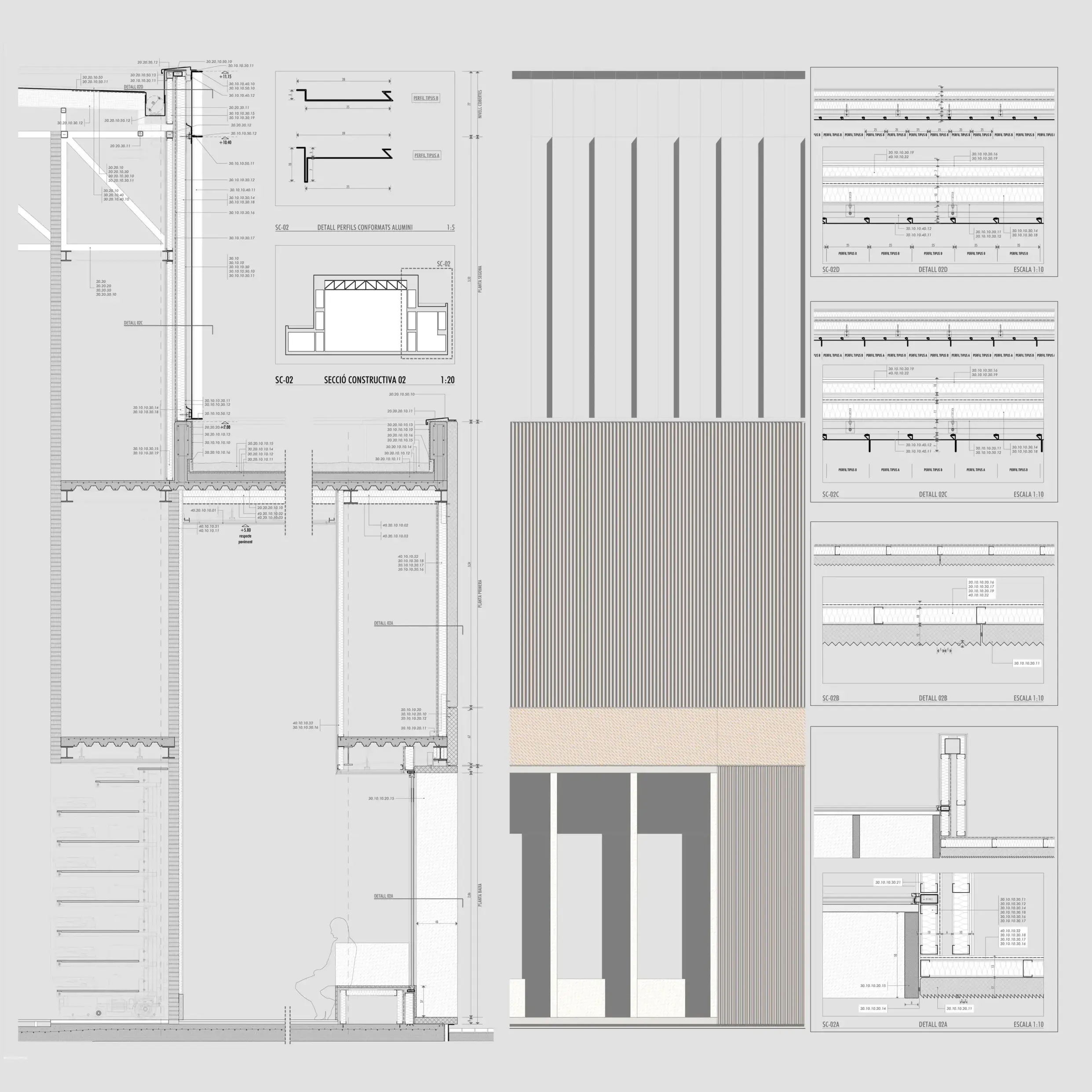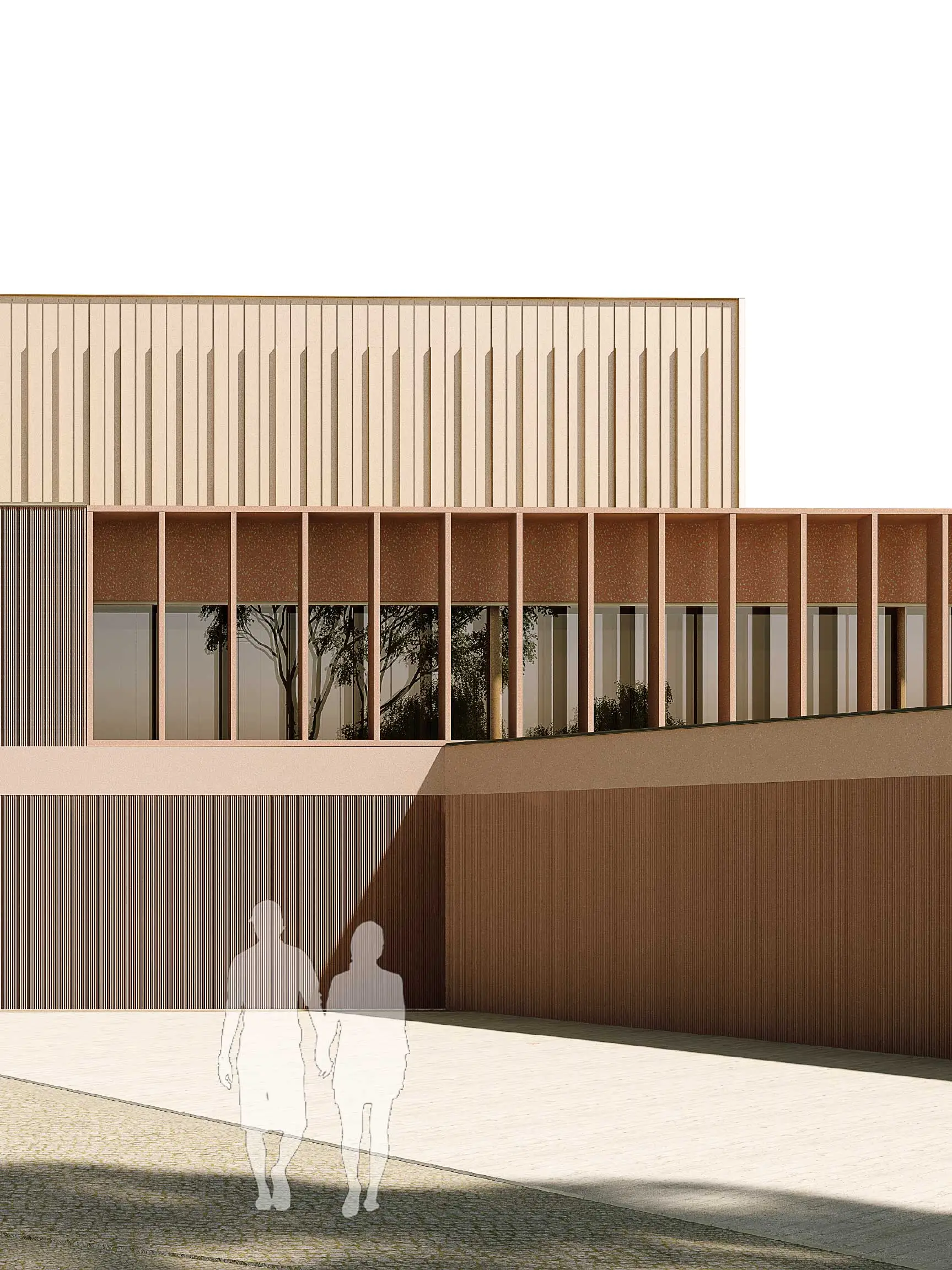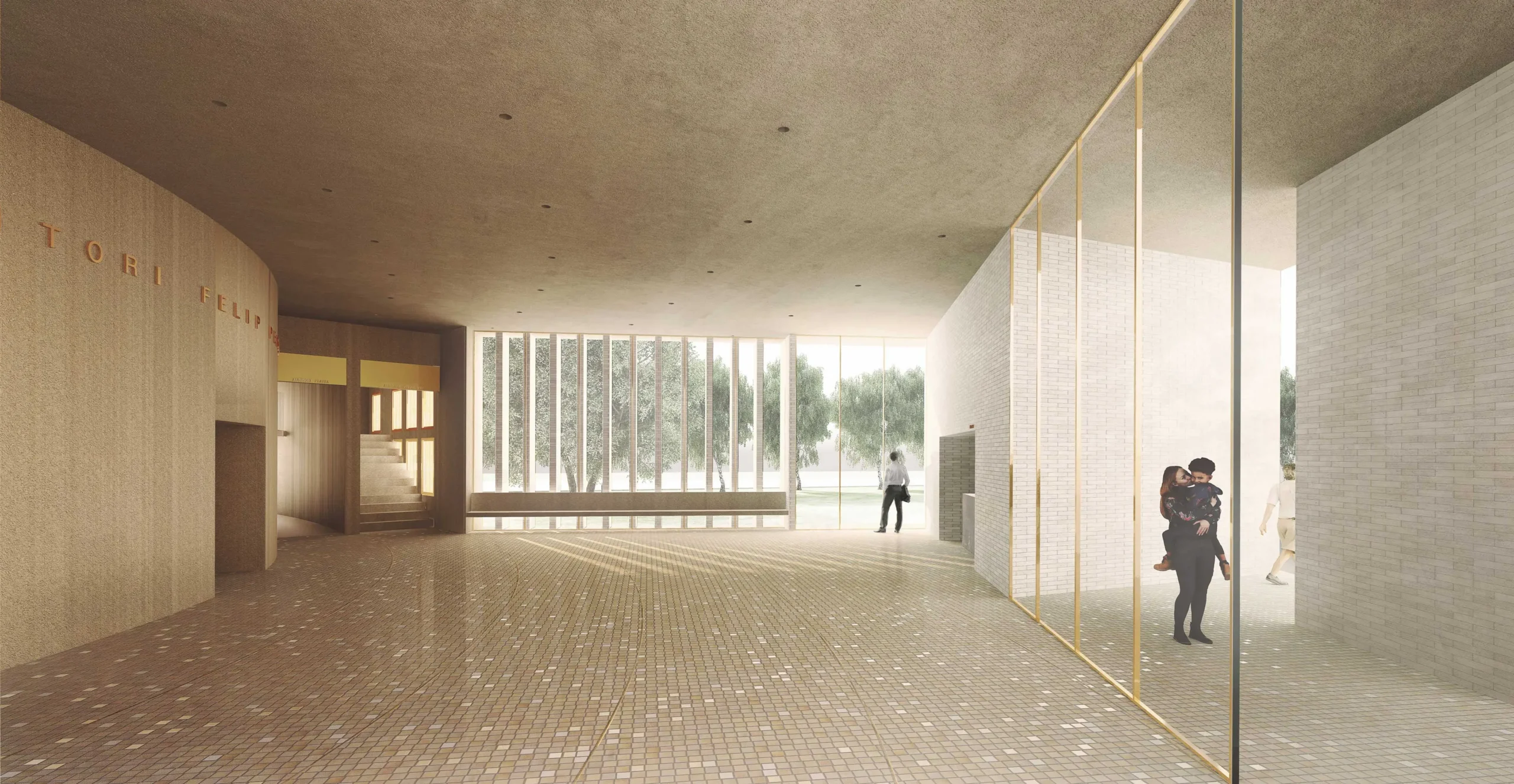Location
Tortosa, Tarragona
Category
Public
Status
Under construction.
Design by FEM (no role in construction oversight)
Year
2021
Tortosa, nestled on the banks of the Ebro River, is a city of layered histories and delicate thresholds. Its urban fabric shifts from the dense patterns of the medieval core to the more rational expansions beyond the railway lines. At this edge — where the historic nucleus dissolves into modern growth — stands the Auditori Felip Pedrell, a cultural landmark that has long embodied the city’s musical and civic identity.
The original building, with its particular geometry and solitary presence, has served as an emblem of cultural ambition. Yet, its placement left it isolated: a jewel stranded within an undefined void, without a dedicated public forecourt or a dignified entrance to mediate between the city and the world of music within.
The extension project emerges precisely here — at this point of transition. It is not only an architectural addition but an urban gesture, one that consolidates the surrounding streets, creates a new civic concavity, and offers Tortosa a place of gathering and cultural resonance. By embracing the proximity of the river, the nearby parks, and the rational geometry of the expanding city, the new intervention stitches together past and present, solitude and community.
Rooted in Tortosa’s deep connection with the Ebre river, the extension orients the auditorium towards the river and promenade. Architecture here is not isolated but integrated, offering a civic plaza that bridges culture, water, and community, reaffirming the auditorium as a cultural anchor within its natural geography.
The urban context reveals the auditorium as a pivotal piece in Tortosa’s geography. Framed by the riverfront and the Teodor González Park, the extension organizes streets, open spaces, and cultural flows, transforming an isolated landmark into part of a continuous urban and natural landscape.
From the outset, the guiding principle was clear: the extension must step into a second plane, allowing the existing auditorium to retain its rightful prominence. The new architecture does not seek to overshadow but to complement — offering support, direction, and continuity.
Yet as the project evolved, the ambitions grew. Initially envisioned as the addition of a secondary performance hall, the design was later expanded, at the request of the City Council, to redefine the very threshold of the building. The modest auxiliary wing became an opportunity to dignify the entrance, to unify the complex with a single architectural language, and to gift the city a new porch: a common access that elevates the act of arrival into a moment of civic pride.
This transformation marks a shift in perception. No longer a backstage annex, the extension becomes part of a larger reimagining of what the Auditori Felip Pedrell can be for Tortosa — a cultural heart with an entrance that reflects its importance, and a spatial choreography that unites the old and the new.
1. Urban Fit of the Proposal: The Unbuilt Space
The extension arises from a gesture of respect: stepping back to let the existing auditorium remain the protagonist. The current urban plan suggests placing new construction parallel to the river, but this would obstruct the main façade and diminish functionality. Instead, the proposal preserves the forecourt as an open void that frames the original building and strengthens its civic presence. By treating absence as a positive element, the project consolidates the urban block while maintaining clarity and dignity for the auditorium, ensuring the landmark continues to stand out within its new context.
2. Rotating the Orientation
The orientation of the new volumes is rotated, while overall surface allocations remain unchanged. This simple shift yields multiple benefits: it connects the new green area directly to both Teodor González Park and the riverfront, integrates the extension more logically with the existing foyer, and clarifies façade hierarchies. Instead of being an isolated object exposed on all sides, the auditorium gains directionality, with a clear distinction between main and service fronts. The resulting ensemble defines a consolidated urban edge, offering a coherent backdrop to the green space while resolving circulation, function, and visibility.
3. Generating a Proper Public Space
Currently, the auditorium stands isolated, lacking its own exterior gathering place. The extension corrects this by setting the new hall slightly back, creating a civic plaza in front of the entrance. This concave forecourt becomes a dignified threshold and an active urban space, animated by public uses like the café and atrium. The intervention integrates with the city grid, weaving building and public space into the immediate urban fabric. Meanwhile, functions are clearly separated: public activity faces the green, while service and technical access remain discreetly organized at the rear, ensuring both civic presence and efficiency.
The early sketches reveal the essence of the project: a gesture of respect towards the existing auditorium, stepping back to create a civic forecourt. These initial lines already suggest the dual aim of the extension — to frame the old building while offering Tortosa a new public threshold.
The journey begins at the newly defined public concavity — a forecourt carved from the urban fabric, oriented to gather visitors as they approach from the surrounding streets. This open space, flanked by the auditorium and the extension, now acts as a civic living room: a threshold where the city meets culture, where waiting, gathering, and lingering are as important as attending a performance.
From this exterior plaza, the new porch announces itself: a protective gesture of welcome, a dignified canopy that frames the main entrance. Passing beneath it, the visitor enters into the reimagined hall — no longer a residual space, but a generous foyer that mediates between city and stage. Light filters through carefully articulated surfaces, softening the atmosphere and preparing the visitor for the experience ahead.
Here, the new atrium extends from the original vestibule, flowing around the smaller existing hall and leading naturally into the new volume beyond. This circulation spine is not merely a corridor but a space of encounter, echoing the layered curtains of a theater: masking, revealing, and guiding. Along its length, moments of pause emerge — a bar-cafeteria opening onto the public square, intermediate waiting spaces, and views outward that connect the interior journey with the wider city. Even when no performance is taking place, these spaces remain active, inviting life and exchange.
At the heart of the extension lies the new performance hall, set slightly apart, acoustically and thermally buffered by the surrounding circulation and service spaces. This separation allows the hall to function flexibly, with retractable seating, overhead grids, and adaptable layouts — a room that can host music, theater, conferences, or community events with equal ease.
Behind the scenes, a clear order governs the flows of artists, technicians, and goods. A rear courtyard organizes deliveries and technical access, discreetly separated from the civic forecourt. Dressing rooms, storage, and service spaces align along the southern flank, ensuring that the professional life of the auditorium remains efficient and unobtrusive, while the public areas are left open and dignified.
The terracotta-toned prefabricated panels echo the ceramic brick of the existing auditorium, grounding the new extension in Tortosa’s material identity. Their vertical striations introduce rhythm and vibration, catching shadows that change with the light, transforming tectonic mass into a living façade of texture, depth, and continuity.
The extension speaks in layers, each material carefully chosen to echo Tortosa’s architectural character while projecting a new, contemporary voice. At its base, the building rests on a plinth of prefabricated concrete panels whose warm terracotta tones resonate with the ceramic brick of the existing auditorium. Rather than appearing as a blunt monolith, this base has been intricately worked: each panel carries a vertical striation, a rhythm carved into its surface with the precision of centimeters, allowing an urban volume of such scale to be shaped with tactile detail.
The reliefs catch the sun, vibrate with shadow, and change their expression throughout the day. As one’s gaze follows these vertical lines upward, the rhythm ascends, intensifying until it finds continuity in the folded sheets of the stage tower above. Here, the copper-colored metal panels, pleated and deepened with relief, extend the same pattern skyward. Their folds create depth and variation, dissolving the building’s full height into layered registers, while the play of light and shadow brings a sense of elegance and movement to the otherwise massive crown.
This dialogue between terracotta-toned concrete and bronzed metal defines the architecture’s voice. The base is grounded, textured, and resonant with the earthy permanence of the city, while the metallic upper volumes shimmer with a changing lightness. Together, they create an architecture of weight and levity, rootedness and ascension — an urban presence that feels at once solid and dynamic, familiar and renewed.
Inside, this material sensibility continues. Exposed concrete recalls the honesty of the original auditorium, while tactile woods and soft finishes bring warmth to the foyer and bar. The layering of acoustic and thermal buffers is not only technical but atmospheric, ensuring that silence, resonance, and comfort become part of the sensory experience of the building.
Beyond its material richness, the extension is a carefully tuned choreography of flows. The public now enters through the new civic forecourt and porch, welcomed into a unified hall that immediately sets the tone of dignity and gathering. Artists and professionals approach discreetly from the south, where a dedicated entrance leads directly into dressing rooms and backstage facilities, ensuring clarity and efficiency in their movements. Goods and technical equipment arrive at a rear courtyard, concealed from the public gaze yet seamlessly integrated into the building’s logistics.
This separation of entrances ensures that audience, performer, and technician each find their place without conflict, while remaining parts of a coherent whole. The bar-cafeteria acts as a hinge between old and new, spilling its life into the public square and activating the complex beyond performance times. Along the circulation spine, lounges and waiting spaces punctuate the journey, offering moments of pause, encounter, and anticipation. Within the new hall itself, retractable seating and adaptable platforms allow for infinite configurations, transforming the space into a democratic room for the city — versatile enough for concerts, theater, conferences, and community gatherings alike.
“
The materiality reflects the city itself: the earthy permanence of concrete below, and the luminous shimmer of bronze above — grounded and light at the same time.
- POL FEMENIAS (ARCHITECT)
The extension of the Auditori Felip Pedrell is more than an architectural addition. It is an urban act, a gesture that transforms an isolated landmark into a civic heart. By uniting the existing hall with the new, by redefining the entrance, and by creating a public plaza where none existed, the project repositions the auditorium as a true cultural threshold between Tortosa and the world.
It is an architecture of respect — stepping back to let the original building shine — and of ambition, embracing the responsibility of dignifying a civic institution. It is an architecture of layers, where materials shift from terracotta earth to bronzed metal, from grounded solidity to luminous abstraction. And it is an architecture of flows, where the journeys of audience, artist, and citizen intertwine in a choreography that extends beyond the walls, into the fabric of the city.
Ultimately, the project is a celebration of what architecture can offer: not only shelter and function, but dignity, encounter, and belonging. In Tortosa, on the banks of the Ebro, the Auditori Felip Pedrell has been given not only a new hall, but a renewed role — as a gathering place, a civic stage, and a timeless companion to the life of the city.
From the striated terracotta-toned concrete to the pleated bronze panels above, the façade composes a continuous vertical rhythm. Each groove, each fold, contributes to dissolving the scale of the volume. Detail becomes order: a tactile precision that elevates an urban mass into a refined architectural gesture.
